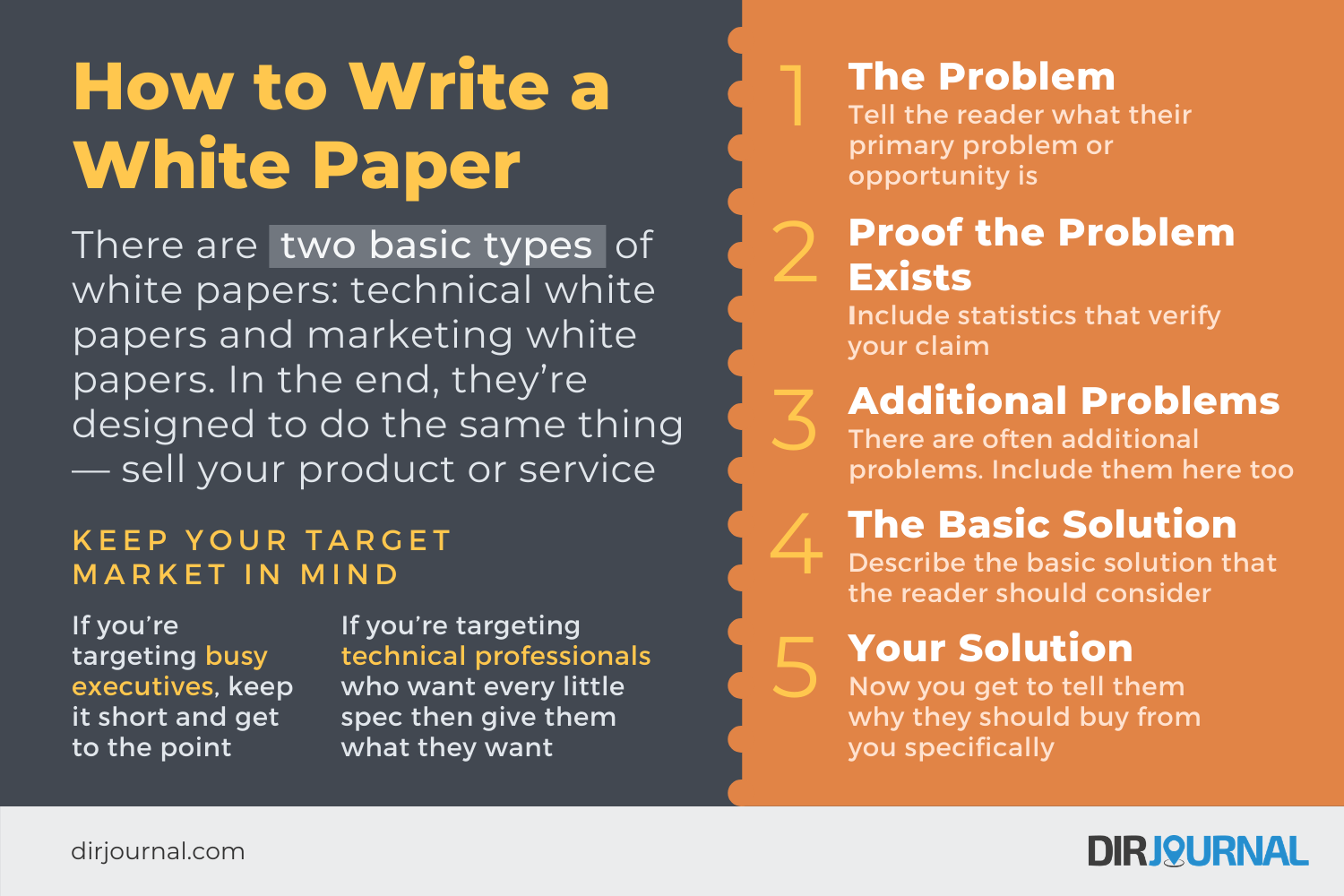Consider learning how to write a white paper if you’re looking to improve your content marketing efforts. White papers, like other long-form content marketing pieces such as case studies and e-books, have the potential to influence people not through flashy sales copy but through informative content. Simply put, you open people up to your marketing message by first giving them content they actually want to read.
If you’ve heard of white paper writing as a marketing tactic already, you probably already know white papers can be excellent tools to drive leads and sales. But what are white papers — and how do you write one? While white papers can seem complicated, they don’t have to be. This article will teach you the basics of how to write a white paper of your own.
Note: There are some differences of opinion in the white paper writing community regarding things like abstracts, best lengths, and rates if you choose to outsource your writing. My opinions are based on years of experience in writing marketing white papers for small businesses, so that is the perspective this article is coming from. Please don’t think that there’s only one “right” way to format or write a white paper.
Let’s get started:
What Is a White Paper?
In short, a white paper is a report. That’s it. Nothing fancy there. Like other business freebies, they’re designed to do two primary things: educate and persuade. Here’s what I mean.
Let’s say your company released a new software package, and you want to increase sales to corporate clients (who will use the software company-wide). You aren’t targeting end consumers. You’re targeting executive-level professionals who are authorized to make that kind of purchasing decision.
 They’re not going to buy your software on a large scale (or switch from another vendor) on a whim. Why? Because there’s a significant cost involved, both in purchasing the software and in training their employees. They want to be educated. They want to know exactly why they need software like yours, and why yours is the right choice for them.
They’re not going to buy your software on a large scale (or switch from another vendor) on a whim. Why? Because there’s a significant cost involved, both in purchasing the software and in training their employees. They want to be educated. They want to know exactly why they need software like yours, and why yours is the right choice for them.
If you can’t make them understand your product, and can’t show them the benefits of choosing your solution to their problem, you won’t make sales. White papers help you do that because they can be longer and more detailed than other marketing copy, such as brochures.
There are two basic types of white papers: technical white papers and marketing white papers. In the end, they’re designed to do the same thing — sell your product or service. Technical white papers have to persuade a more technical audience. They’ll be heavy on specs, whereas marketing white papers can be used to promote just about anything. For the scope of this article, let’s stick to marketing white papers.
What’s in a White Paper?
So you know your white paper has to educate someone about your product or service, and it has to convince them to buy from you. How does it do that? Let’s oversimplify.
When you write a white paper, here’s what it should say to the reader:
White Paper: “You have a problem, whether you know it yet or not — a big problem for your business. Here’s what that problem is and proof that it affects businesses like yours.”
Reader: “Oh no. You’re right. That is a problem.”
White Paper: “That problem might even be tied to other, smaller problems. Uh oh, you’d better find a solution, and fast.”
Reader: “Wow! I didn’t realize all of that. Okay. Quick. Give me a solution.”
White Paper: “You’re in luck. Here’s an idea that could make all of your problems go away. Let me describe the basic solution for you without shoving a marketing message down your throat yet to help you understand it better.”
Reader: “Great. I think I understand, and I agree — that sounds like it might work and be really good for my business. Any specific recommendations on who to hire?”
White Paper: “Um, yeah. Me! Here’s why my company or my product meets your needs.”
Reader: “Sign me up!”
Okay. That’s obviously not quite what’s going through a reader’s head, but it shows you the intended train of thought when moving from one section to the next of the basic white paper outline.
Elements of a White Paper
Here’s what that outline looks like:
- The Problem (or Opportunity)
- Proof the Problem Exists
- Additional Problems
- The Basic Solution
- Your Solution (the Marketing Message)
White papers can include more than those five elements, but these are the most important, and the ones that should be included in any white paper you write. You might also choose to include a title page, abstract, illustrations (like charts and graphs), sidebars, a separate benefits section (instead of including benefits in your general solution), guidelines on how to choose a provider for the solution (before pitching yourself), and more. Since you’re probably learning how to write a white paper for the first time though, let’s focus on keeping it as simple as possible.
Sections and What to Include
Now let’s look at what should be included in each of those sections when you write white papers.
- The Problem — This is the introduction to your white paper. It will tell the reader what their primary problem or opportunity is. This may be something holding back their own business, or an opportunity to drastically increase sales or productivity, for example. Your introduction shouldn’t be more than a page long. You want to get the problem across quickly in order to grab the reader’s attention.
- Proof the Problem Exists — You say there’s a problem for the reader. So what? Why should they believe you? After exposing them to the primary problem, you need to back it up with market research. This is where you’ll include statistics that verify your claim.
 Additional Problems — Sometimes the initial problem is enough to get the reader’s interest, but not enough by itself to make them feel that action is necessary now. There are often additional problems that could be addressed by the same solution. Include them here.
Additional Problems — Sometimes the initial problem is enough to get the reader’s interest, but not enough by itself to make them feel that action is necessary now. There are often additional problems that could be addressed by the same solution. Include them here.- The Basic Solution — Don’t jump into talking about your own product yet. This is still a part of the educational aspect of the white paper. You should describe the basic solution that the reader should consider. For example, if you were trying to sell software as mentioned earlier, here you’d make a case for your type of software — not your company. This section should also cover the benefits of the solution to the reader. Remember, as in all forms of copywriting, focus on benefits rather than features.
- Your Solution — Here’s where you get to toot your own horn. You’ve (hopefully) convinced the reader that they like your basic solution. Now you get to tell them why they should buy from you specifically. I like to keep this to a single page — I almost treat it as a flyer, showcasing intro copy to highlight specific benefits, any information that sets your product apart from the competition, and then a call to action. You should always include a call to action (send them to your website to order, have them call a rep to answer their questions, etc.). Without a call to action, why did you just get them to read through the white paper?
Formatting and Titling
Now that you know the basics of how to write the white paper’s content, how should it look? While I’m not sure if you’ll consider it fortunate or unfortunate, there’s no right way to format a white paper! Some white paper writers like to use a single format for all of their clients. Others adapt from one to the next. I often let the supplementary material decide.
For example, if there will be a lot of charts and graphs, I’ll go with a full page format to allow more room for the graphics. If it will have few graphics and I’d rather use pull quotes for visual interest, I might go with a two-column format where quotes and small charts go in a sidebar area, keeping the main body text free-flowing.
Title Pages and Abstracts
 You’ll also have to decide whether or not you want to include a title page and abstract (that is, a short summary of the white paper content). Here’s the rule I go by: If I include a title page, I include an abstract. If I go right into the content on the first page, then I leave the abstract out. Why? Because if I’m going to put an extra page between my reader and my main problem paragraph, then I want to give them the gist up front — a reason to open it. Sometimes a title and sub-title will be enough, but not in every case.
You’ll also have to decide whether or not you want to include a title page and abstract (that is, a short summary of the white paper content). Here’s the rule I go by: If I include a title page, I include an abstract. If I go right into the content on the first page, then I leave the abstract out. Why? Because if I’m going to put an extra page between my reader and my main problem paragraph, then I want to give them the gist up front — a reason to open it. Sometimes a title and sub-title will be enough, but not in every case.
A title page isn’t necessary, although many companies include them. What I suggest is that you choose whichever format you’re most comfortable with, but try to keep things consistent with white papers released through your company moving forward. Just make sure that if you don’t include a title page, your company name, logo, and contact information are clearly visible on the first page.
Speaking of titles, here’s a rule I follow and suggest: Forget about catchy and cutesy. The white paper title does have to get attention, but it should more importantly tell the reader what’s coming. Because of that, I believe it should always include a mention of the basic problem and the target market. You need to scream “Hey, this white paper is for you!” Save the fluff for consumer marketing if you must; not B2B.
Length
How long should your white paper be? Again, there is no right answer. It might be five pages. It might be 50 pages. I’ve found that most of my clients prefer white papers in the 5-10 page range. However, the more technical the material, the more information might have to be included.
So there’s nothing wrong with a longer white paper. Just keep your target market in mind. Ask yourself, “Will they read this?” If you’re targeting busy executives, keep it short and get to the point. If you’re targeting technical professionals who want every little spec and detail, then give them what they want.
Hiring a White Paper Writer
If you’re not comfortable with the idea of writing white papers yourself yet, you might opt to hire a business writer. Some writers specialize in writing nothing but white papers. Other business writers and copywriters write white papers in addition to other types of copy (such as e-books, press releases, email marketing campaign copy, brochure copy, etc.).
If you already have a business writer working for you, I would suggest seeing if they’re capable of writing a white paper first. If they’re already intimately familiar with your company, products, and target market, they’ll be well-equipped to handle your project for you.
Just know that white paper writing won’t come cheap (if the writer is well-qualified and experienced). It’s not uncommon to pay more than $1.00 per word for a white paper, sometimes quite significantly more. Expect at least a low-to-mid four-figure budget if you want to hire someone experienced. As with all things white paper related, there’s no “right” price to pay. That’ll vary significantly based on specialty, location, experience, and other credentials.
Learn to Write White Papers
If you want to learn how to write a white paper of your own, it’s a great idea to take some time to search the Web and read a few white papers. Look at some in your niche, and look at some outside of it. You’ll find many different formats, lengths, and styles, and looking at samples will be one of the best ways for you to decide what you do and don’t like when it comes to writing white papers.
Do you have some favorite white paper examples to share? Link to them in the comments and offer your own tips on how readers can learn how to write white papers for their businesses.
Note: This post was originally published on September 1, 2009. It was updated with some new content on its currently-listed publication date.








 Additional Problems — Sometimes the initial problem is enough to get the reader’s interest, but not enough by itself to make them feel that action is necessary now. There are often additional problems that could be addressed by the same solution. Include them here.
Additional Problems — Sometimes the initial problem is enough to get the reader’s interest, but not enough by itself to make them feel that action is necessary now. There are often additional problems that could be addressed by the same solution. Include them here.





Tried to sign-up for the Execlusive Directory Repoert and Your path would not accept my email address.
Thanks Roger. I notified the blog owner, and he let me know the sign-up form is now fixed.
Very informative and helpful. Could you please add some samples.
Do a search for free white papers and you can find thousands of them on the Web. It’s a bit harder to find strictly marketing white papers (as opposed to technical white papers) because they’re often distributed directly to clients, on a company’s site instead of via directories, or at industry events. But sites like http://www.findwhitepapers.com and http://www.whitepapercentral.com have some you should be able to access (the latter site has a few on the homepage currently that look like strict marketing ones — the variety outlined in this article).
Hi Jennifer,
Bulls-eye information on marketing white papers. Can you please provide information on technical white papers as well. There are tons on the web, and more of marketing whitepapers. I want to know what information goes into the technical whitepapers?
Appreciate your early response.
Thanks a ton 🙂
Unfortunately technical white papers aren’t my strong suit. I’m not a technical writer and don’t write them in my business, so I wouldn’t be comfortable giving advice on them specifically. But you could check out Mike Stelzner’s book Writing White Papers or visit one of the sites below. Maybe one of these links will give you the info you’re looking for.
1. http://www.thatwhitepaperguy.com/white-paper-articles.html
2. http://www.stelzner.com/copy-HowTo-whitepapers.php
3. http://www.mwknowles.com/free_articles/white_paper/white_paper.html
Yes, I agree with you. Technical reports can be extremely hard to deal with, if you don’t have the necessary technical acumen.
Excellent. You actually wrote the article like a white paper for people wanting to write white papers. Very clever. I am a techie starting up a business and needed to write a marketing white paper. This will most definitely help.
Thanks.
Very true, Bowie.
I was thinking the same thing. And I was looking for the hook at the end, and there wasn’t one.
Great article, Jennifer.
Glad you enjoyed it Kevin. 🙂
[…] not to use it. Here’s a website that offers further advice on how to organize your white paper: how to write a white paper/ […]
my famliy is very busy of writing papers at home yesterday. also i went to school today & i have to do an journal and i just wrot my, my famliy just ate last night.
Great article Jennifer, and I really like the “problem/solution” aspect of this. Bookmarked this, and again – my thanks!
Chris
This is useful article based on years of experience in writing marketing white papers. I hope it will teach others the basics of writing white paper.
Nice post. I didn’t even know what a white paper was until now. Thanks!
very nice and easy…..I Know now…thankyou.
Jennifer:
I didn’t know what a white paper was, so I looked on the Internet and found you. Thank you so much for your content and quick and easy style. Your ideas flowed so easily and you explained everything so well, that I am going to write a white paper marketing my business!
Thank you, again!
I love the conversation bit! It helped me get it clear in my head the difference between a white paper and marketing spiels
Minutes ago, my knowledge about white paper was indeed white. This article is clearly written and very easy to understand. I have become educated. Thank you!
I really find this article useful. The funda of white paper is clear. Thanks for this nice post.
Jennifer! Very informative and well drafted post! Thanks very much for the information shared.
Hi Jennifer,
Very informative article. Thanks.
I am looking for a white paper on supervisors connecting with their respective resources. can you please help me?
Thank you very much for the simple but detailed and well though out outline. I’ve been asked to write a white paper for a good friend, however I needed clairifcation before I committed myself to this completely. I will definitely use this amongst other that you’ve suggest as my guide and template moving forward.
Sincere Thanks,
Great article!
I like your face, and you write a darn good article.
Success,
Charles
Dear Ms. Mattern,
Thank you for your informative and concise article. It has helped me to understand what it means when someone refers to “white papers” and how they relate and compare to the military correspondence I routinely write and edit. Your writing style also appeals to me. Your casual approach and candor come through very strongly and give your prose a credibility I do not think can be faked. I almost feel it was written directly to me. Thanks for the help.
Sincerely,
Dave Hart
You’re very welcome Dave. I’m glad you found the information, and the style of the article, helpful. 🙂
Great article! One question. When writing a marketing white paper, do you include the “cons” of the product? My potential client wants a white paper that touts the benefits and I was wondering if a few mild “cons” would make it seem meatier? The cons for this industry are very minor but not sure if that’s important.
Thanks!
In general you won’t share cons of your product in a sales pitch. And that’s what the last section of your marketing white paper is (and the only place in the white paper where your product should even be mentioned). I suppose it makes sense if the cons are minor and you plan to compare multiple options in the general solution section of the white paper before pitching the customer’s own product though.
[…] question in everyone’s mind is: “What are white papers exactly?” According to Jennifer Mattern’s post on Directory Journal, white papers are reports that are written to do two things: to inform and to persuade. She goes on […]
[…] tips can help you in getting started in how to write a white paper template. Do note, however, that in order for the white paper to help you achieve your company’s […]
[…] If you’ve done any research into marketing tactics, you might have come across white papers, hearing that they can be excellent tools to drive leads and sales. But what are they and how do you write one? While white papers can seem complicated, they don’t have to be. How to Write a White Paper […]
Very nice article here. I was researching on how to write white papers and this post really helped me a lot. Now I just need to look at some examples from the links you gave to one of the commenters and I should be good to go.
Thanks your for sharing.
[…] How to Write a White Paper […]
Nice clear directions and writing style. Helpful for those who want to know how to write a white paper.
Very clear and concise! The best description I’ve come across. Thanks for your help!!!
Excellent set of instructions. Thank you!
Hi Jennifer. Thank’s for a great article on how to write a white paper. Your article is very clear and simple and it makes me think that even I can write one successfully.
Thanks for the narrative on white papers. I really appreciate your efforts!
Excellent article! Your explanation and examples were so easy to understand, stated in a very simple and friendly style. Thanks so much.
Hi I have to appraise and critique Government white papers and policy documents I have used as evidence for a service improvement can anyone help?
Thanks
Hi Jennifer,
Thank you so much this is short and to the point.
I have a Non-Profit that helps Veterans and Families that are Homeless and I wanted a way to really share not only what our family experienced and also what we learned and why we started “Sharing It Forward”.
Through the experience of being homeless I found my purpose and our family was able to understand why we experienced such a difficult challenge.
Our whole family is now committed to do something about this situation.
Being able to communicate what we learned and our experiences will help us in sharing our knowledge and ideas.
And hopefully bring in donations and corporate sponsors.
Wealthy Wishes.
Kristen
As a freelancer, how do you determine what to charge for a white paper?
This has given me confidence to write my own white paper for a senior management group of a multi national company,
Thank you so much for sharing great knowledge
Hi Jennifer,
I’m techie person and was wondering how do I start writing my white paper, when I didn’t even know what exactly a white paper is. There you came into my help and the best part is your article is very easy to understand and follow. Hopefully I can write my own now. It would be great if you can also help us with the process of getting it published.
Thank you so much !!
Pritam
hi, i found this article very useful, although i still feel a bit confused with the contents that i need to focus on, along with the related tasks.
Its basically an assignment on corporate branding…. what do you think is the most suitable approach?
Tnx..
Hello
Just wanted to drop ou a line to let you know that I found your article very clear and to the point. Very easy to understand and put to practive.
Thank you!
Thank you for the kind words Karen. I’m glad you found the article helpful. 🙂 Do you plan on writing a white paper of your own any time soon?
Jerry ,
It is very good paper for beginner and professional too.It is easy to understand.
M Z Rahman
Hi Jennifer,
It is precise,crisp,simple and apt paper on white paper.Thanks
M Z Rahman
[…] How to Write a White Paper (my article on a client’s blog) […]
[…] How to Write a White Paper […]
Very Informative Article by Jennifer on White Paper.
Thanks & Regards,
Prashant S Akerkar
that was great to prepare a white paper but i want to be specific.
so, will you please give me the information about a specific white paper which will notify particular product which is produced by number of companies
[…] White Paper: A white paper is a piece of advertising material that explains in detail the benefits of a particular product. It’s more of a report than a brochure, and is usually multiple pages long. For help writing white papers, check here. […]
[…] styles are more popular than audio. If you’re familiar with whitepapers, you know that the voice always takes on an academic overtone that’s supported by scientific […]
Thanks! I’m in a crunch with two white papers due for a client. Your article gave me the “down and dirty” I need to get started.
[…] To learn how you can create a powerful white paper, click here. […]
Nice article
Thanks a lot, I really needed it. it’s very helpful.
very useful, thanks a lot!
Hi Jennifer
somewhere along your article, I read that you do write White Paper for clients. I am looking to cover this for my business idea, and rather leave it to an experienced writer. I wish I could spend more time learning to do this properly myself, but my time and attention is needed on the business.
Let me know if you are interested to understand my business and prepare a white paper for me.
Kip Dugal
Hi Kip. Right now I’m not taking on many new clients. There is usually a wait of anywhere from two to six weeks for availability depending on the size of a project. You can learn more about my business writing services at http://ProBusinessWriter.com.
If you need something quickly, if my rates aren’t in the budget you’re considering, etc. you can check out the professional freelance writer directory I manage under the “Jobs” link at http://AllIndieWriters.com. There you can find profiles for pro-level freelance writers, and you might be able to find someone who specializes in white paper writing and who happens to have an opening in their schedule right now.
If nothing else, feel free to contact me through my business site with details about your business and white paper plan. If it’s not something I can help with, I might be able to refer you directly to someone else who might be a good fit depending on your industry.
Thanks this is very helpful.
This is a really, really useful post, and it’s really, really well-written. Thank you!
Thanks Cassie. I’m glad you liked the post. 🙂
Just wish to say your article is as amazing. The clarity to
your put up is just excellent and i could assume you’re a professional
on this subject. Fine with your permission allow me
to seize your feed to stay up too date with approaching post.
Thank yoou a miillion and please carry on thhe gratifyin work.
Good article on White Paper
[…] Further reading: Quora Community Rules: A Starter Guide for Joining the Conversation. Here’s also a great tutorial on how this Q/A content can be turned into a whitepaper. […]
[…] How to write a White Paper: http://www.dirjournal.com/business-journal/how-to-write-a-white-paper/ […]
WOW! what an impressive write up.I would say the content is still relevant, helpful and up to date even in 2016.
[…] company and can afford the price tag, it is worth the investment. This is also a great way to put together a truly useful whitepaper to position your brand as a knowledge […]
[…] your newsletter. A few good examples of content-based lead magnets are checklists, cheat sheets, whitepapers, and […]
[…] your newsletter. A few good examples of content-based lead magnets are checklists, cheat sheets, whitepapers, and […]